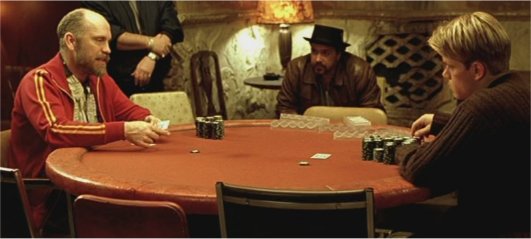Unsatisfied With Satisfaction?
In Rounders, the greatest poker movie of all time, John Malkovich, brilliantly playing the role of antagonist Teddy KGB, states in his thick Russian accent, “I feel so unsatisfied,” after a short poker session in which protagonist Mikey McDermott (played by Matt Damon) wins a quick $5,000 and proceeds to stand up and walk away from the poker table. Here, KGB is appraising his level of satisfaction (or dissatisfaction) with the transaction itself.
 According to Merriam-Webster, satisfaction is “a happy or pleased feeling because of something that you did or something that happened to you; a result that deals with a problem or complaint in an acceptable way.” In other words, satisfaction is process- or transaction-based. Therefore, customer satisfaction should not be used as a relationship measure or predictor of growth or loyalty, but instead as a mechanism to assess things like product quality and transactional service experience.
According to Merriam-Webster, satisfaction is “a happy or pleased feeling because of something that you did or something that happened to you; a result that deals with a problem or complaint in an acceptable way.” In other words, satisfaction is process- or transaction-based. Therefore, customer satisfaction should not be used as a relationship measure or predictor of growth or loyalty, but instead as a mechanism to assess things like product quality and transactional service experience.
Organizations often mistakenly use customer satisfaction to gauge the nature of the relationship with the account, as opposed to sentiment pertaining to a specific situation. Many also incorrectly assume that a satisfied customer is a loyal customer. Customer satisfaction does not mean or measure loyalty. Nor is satisfaction a proxy for loyalty; thinking otherwise will lead you to poor decisions. To illustrate this, business author and customer loyalty strategist Fred Reichheld (author of The Loyalty Effect and The Ultimate Question) shared an analysis that revealed that 60 to 80 percent of customers that defected from a brand pronounced themselves as “satisfied” or “very satisfied” before defecting. Management fatally assumed that those who stated they were satisfied didn’t need to be further cultivated.
Loyalty, on the other hand, refers to the quality or state of the relationship. Merriam-Webster defines loyal as “unswerving in allegiance; faithful to a cause, ideal, custom, institution or product.” For example, as a lifelong New York Jets fan, I am loyal to a fault. I bleed green, although year after year, they prove to be the most inept franchise in all of (American) football. Being a Jets fan is similar to Charlie Brown attempting to kick the football that Lucy pulls away at the last minute, leaving Charlie on his back, time after time after time after time. Yet every September, I’m optimistic that this is finally the year! In anticipation and excitement, I buy the latest Jets merchandise and attend/view games. I’m loyal, yet dissatisfied…extremely dissatisfied!
As you see, you can be satisfied and not loyal. You can be loyal and not satisfied. So, as an organization looking to assess how your customers feel about you, what’s the answer? The answer is that successful organizations use both satisfaction and loyalty measures. There are different techniques/methodologies to measure satisfaction and loyalty. To determine which path forward, organizations must know what they are ultimately trying to assess and what they plan on doing with the information collected. If there is no strategy in place or resources to positively impact the customer experience or capitalize on customer loyalty based on what you learned, don’t waste resources giving it lip service. You’d be better off taking that money and sitting down at the poker table with KGB.